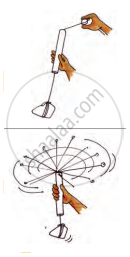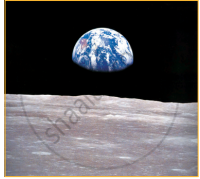Advertisements
Advertisements
Question

- Can you see India?
- Can you recognize any other place?
- Where is the sea?
- Do you find anything similar between the globe and this picture of the earth? In what ways are they different?
- Do you think Sunita could make out Pakistan, Nepal, and Burma separately when she saw the earth from space?
Solution
- Yes, I can see India.
- Yes, I can recognize Sri Lanka.
- The blue colour on the globe indicates water.
- Similarities between the globe and the earth are that we can identify which part is land and which part is the sea. But it is difficult to identify a particular country or a city on the globe.
- No, it is difficult to identify these countries, since no particular country can be visible from space.
APPEARS IN
RELATED QUESTIONS
What do you think the earth looks like? Make a drawing of the earth in your notebook. On your drawing show where you are. Take a look at your friends’ drawings too.
Close your eyes. Imagine that your class is a spaceship. Zooo...m – in 10 minutes you have entered space. Your spaceship is now going around the earth. Now say:
- Are you able to sit in one place?
- What about your hair?
- Oh, look … where are your bags and books going?
- what is your teacher doing? Where is her chalk?
- How did you eat your food during the break? How did you drink water? What happened to the ball that you threw up?
Can you now say why Sunita’s hair kept standing?
Think why water flows downwards on any slope. On mountains, water flows downwards, not upwards.
To play this you will need a small stone, a bigger stone (lemon-sized), a thick roll of paper (which can be made with layers of paper), a mouse, and an elephant made of paper.

- Take a string about 2 feet long.
- At one end of the string tie the small stone. Stick or tie the mouse to the stone. - Put the string into the roll of paper.
- At the other end of the string tie the bigger stone and stick the elephant.
- Hold the roll of paper and move your hand to rotate the small stone.
- Who is pulling whom? You will be surprised! The mouse lifts the elephant! How did this magic happen?
- Can you find the state in which you live? Write its name on the map.
- Which are the states next to the state you live in?
- Have you been to any other state?
- Shahmir thinks that there are lines drawn on the ground between the states. What do you think?
Do you think the moon is flat like the coin or round like a ball?
At night look at the sky carefully for 5 minutes.
- What could you see?
- Did you see anything moving in the sky? What do you think it could be? A star or a shooting star or a satellite (satellites are used for the TV, telephones, and for weather reports). Find out more about this.
See how the earth is looking. Can you see the surface of the moon? Do you have some questions after looking at this picture? Write down those questions and discuss them in the class.

Why don’t you try to do the same with a coin? How many centimeters away from the eye did you keep the coin to hide the moon?
